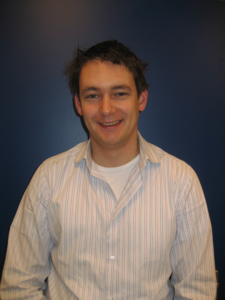In-situ growth monitoring with scanning force microscopy during Pulsed Laser Deposition
Promotion date: 10. April 2008
Promotor: Prof. dr. ing. Dave H.A. Blank
Assistant promotor: Dr. ir. Guus Rijnders, dr. ir. A. Brinkman
| This thesis describes a setup for in-situ growth monitoring with Scanning Force Microscopy (SFM) during Pulsed Laser Deposition (PLD). The setup is designed to study oxide growth during PLD. The sample was transferred towards the PLD-position during deposition and moved back to the SFM-position to continue imaging. It has proven to be feasible to study the nucleation and growth “quasi” real-time, even though the positions are separated by 60 mm. The conditions are harsh: low deposition pressure and a substrate temperature between 500 – 850 Celsius. A larger oscillation amplitude of the tip improves the measurement stability. In the dynamic mode the tip is oscillating with a certain vertical speed. While imaging it is recommended to use dynamic mode SFM and increase the vertical tip oscillation speed. |
Can you mention some important features of the techniques studied in this thesis project?
The main objective was to obtain more parameter information during the deposition process, in order to gain better results, using less experiments.
The sample is fired to and fro, between two consecutive deposition events to the SFM position. In order to monitor the area effectively, using the fragile microscope tip, we proposed a technique moving the tip up and down with a small angle. This procedure was patented successfully.
Do you still use aspects of this project in your company, SolMateS?
SolMateS which stands for Solutions in Material Science started two years ago, as a spin-off company of the MESA+ institute of Nanotechnology.
SolMateS has expertise in the field of thin films and material science and has two branches. The first branch provides technical consultancy, which means: contract research, material analyses and feasibility studies. The second branch develops own products. Since our start in 2006 we have one production joint venture called Sumipro coatings, which coats polymer optics for military applications.To deposit these coatings on plastic, SolMateS has developed a unique and patented deposition processes. This technology is now also applied in different fields such as the MEMS market. For the MEMS market we are currently optimizing piezoelectric thin films on 6” Si wafers.
These functional thin films can be used for various applications. It is expected that we produce the first wafers with oxide electrodes this summer. These piezo electic layers and MEMS devices can play an essential role in for example the new generation printer heads.
What are your ambitions within, say, five years?
SolMateS is a highly ambitious company aiming at an own R&D team of five up to ten experts, within five years. That is a vital mass to make a difference. This R&D team is still doing contract research and assists the product development of SolMateS.
However, the biggest challenge is to make one of our product lines to a successful independent business unit. We are still working on gaining knowledge of the needs of our customers, and getting to know new customers and market contacts. If we succeed well on this, I reckon we are able to grow to a company of up to thirty employees.
What, in your opinion, is important for MESA+ to stay successful?
First of all, there is the need to keep investing in cleanroom facilities. Then companies and researchers will be challenged and willing to stay and come here. The combination of researchers and the presence of companies, is a strong selling point of Twente. Also to maintain the focus on “nano” is of vital importance.

